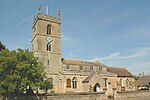Charlton Halt railway station (Oxfordshire)
Disused railway stations in OxfordshireFormer London and North Western Railway stationsPages with no open date in Infobox stationRailway stations in Great Britain closed in 1917Railway stations in Great Britain closed in 1926 ... and 4 more
Railway stations in Great Britain opened in 1905Railway stations in Great Britain opened in 1919South East England railway station stubsUse British English from May 2017
Charlton Halt was a railway station on the Varsity Line 1 mile (1.6 km) north of the village of Charlton-on-Otmoor. The London and North Western Railway opened the halt in 1905 and the London, Midland and Scottish Railway closed it in 1926.
Excerpt from the Wikipedia article Charlton Halt railway station (Oxfordshire) (License: CC BY-SA 3.0, Authors).Charlton Halt railway station (Oxfordshire)
Mansmoor Road, Cherwell District Charlton-on-Otmoor
Geographical coordinates (GPS) Address Website Nearby Places Show on map
Geographical coordinates (GPS)
| Latitude | Longitude |
|---|---|
| N 51.85244 ° | E -1.19563 ° |
Address
Woodsides Meadow
Mansmoor Road
OX5 2US Cherwell District, Charlton-on-Otmoor
England, United Kingdom
Open on Google Maps









